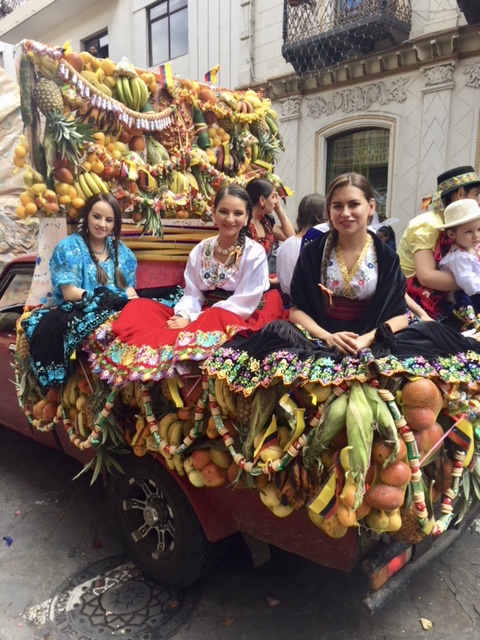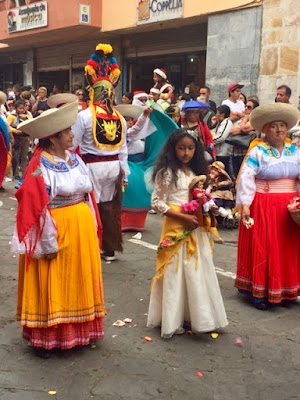For weeks I had been watching the calendar advance toward Christmas, yet I couldn't believe it was true. Warm sunny days and swaying palm trees do not fit into my schema of Christmas, never mind the absence of my own family, and all of my favorite traditions of decorating, baking, and gift-giving. As we rolled into mid-December, it became clear to me that Christmas in Ecuador was going to be an entirely new experience without a cozy sweater! Read on to learn about some similarities and differences between our cultures.
In many ways, Christmas in Ecuador is celebrated in similar ways to the US with festivities and family. Students get two weeks vacation from school. People do decorate with artificial trees, and lots of colored flashing lights inside their houses and businesses. Outside lights are reserved for the city parks where various characters light up the night. Santa Claus, or Papá Noel, and his reindeer are a jolly novelty in the mall, but he doesn't bring presents to the kids. In fact, many families only give children one or two small gifts, or don't exchange presents at all. Baking is not common in homes in Ecuador, but they do buy candy to share - especially caramelos. Christmas Eve is the celebrated day where families attend church and prepare for a celebration at Midnight when they open presents or eat a large meal together. Turkey is the favorite food for their Christmas Eve Dinner. Christmas Day is a national holiday to spend with your family or attend church again. Nothing more.
To share a little of my traditions with them, I did bake some Snickerdoodles with my brothers (my favorite Christmas cookie!) and I made my family a fresh squash pie. The crust was really puzzling for them and we ate it after we finished making our candy houses together- see my previous blog post. I also gave them some gifts, which they really enjoyed. Unfortunately, I can't make snow, and I am realizing that I miss this most of all.
Christmas in this predominately Catholic country is really about the birth of Christ. For this reason, the centerpiece of Christmas decorations is the bélen, or pesebre. Every home, classroom, and office has a bélen where the creator can show off their artistic vision of the scene where Jesus was born.


It's important to note that what you have in the bélen isn't important, just as long as every character is waiting expectantly for Jesus... including Santa. Also, throughout the year, it is customary to buy little representations of animals and people to put in your bélen so the proportions of the characters don't really matter either. Therefore, it is common to have animals represented that are larger than either Mary or Joseph, which, for example, are really tiny in the bélen above.
This is Tía Carmen's house with her bélen and Christmas decorations outside on her patio.

 Large beléns are also represented in city parks. Over the course of several days, I cooed over many different creches, but something was troubling me about them all. When we visited this bélen in the park, the problem was so obvious, I had to say something. "It's very beautiful, but they forgot the Baby Jesus". My family laughed and explained that the Baby Jesus is added with big fanfare on the 24th of December to represent his arrival.
Large beléns are also represented in city parks. Over the course of several days, I cooed over many different creches, but something was troubling me about them all. When we visited this bélen in the park, the problem was so obvious, I had to say something. "It's very beautiful, but they forgot the Baby Jesus". My family laughed and explained that the Baby Jesus is added with big fanfare on the 24th of December to represent his arrival.
For Christmas, I traveled to the historic city of Cuenca where I visited many beautiful churches with very elaborate bélens.
The New Cathedral in Cuenca had a bélen so large, it filled one-third of the church. Look closely for all the people and animals represented in the scenes below. They mechanically moved as the lighting changed for daytime and night.
Another important part of the Christmas tradition is to celebrate the Novenas. For the nine nights leading up to the 24th, family, neighbors and friends gather together in people's houses for small prayer meetings. There's an official prayer book, and traditional songs to sing. I'm not a religious person, so I wasn't sure what to expect, but I found these gatherings very enjoyable. Each of the three I attended were very different, but all were engaging and participatory. In some, people took turns reading and answering thoughtful questions about how the readings pertained to their lives today. Others handed out musical instruments to enliven the celebration. It is a lovely way to connect with others around the holiday.
In Cuenca, the morning of the December 24 is a grand occasion. We came upon the morning mass in the New Cathedral (built for over 8,000 people) where they were celebrating the Baby Jesus with decorated guards, songs and a prayer service.

Then we headed into the streets to witness the Pase del Niño, a parade in which the likenesses of Baby Jesus are carried through the streets and celebrated by a cast of historic and modern characters. Over the course of more than 7 hours, we watched floats, bands, dancers, and families in all kinds of costumes with kids, dogs, sheep and horses parade past.



Over the course of my travels, we saw a few different Pase del Niño parades in different towns on different days. In one town, we were told that the Baby Jesus dolls were being carried by the families who had lovingly taken care of them throughout the year. Then, at the end of the parade, after they situated him in their community creches, he would be passed onto a new family who was tasked with caring for him until the next year. In this way, many families from different neighborhoods were involved in the tradition and the celebration.
In Ecuador, Christmas is celebrated from at least December 16th until January 6th, which is the Día de Reys, or Three-Kings Day. On this last day of Navidad, everyone took to the streets again for more music, dancing, drinking and of course, the ever-present fireworks exploding into all corners of the sky. They really know how to celebrate Christmas in Ecuador!




























Becky, I'm absolutely fascinated with your posts. Thank you so much for sharing your experiences with us! Hugs to you!!! Love, Linda
ReplyDelete